When it comes to manufacturing, machining technology is an indispensable link. The machining process is the process of converting raw materials into the required shape, size and surface quality, covering a variety of precision machining methods to meet the needs of different parts. The following will introduce 8 common machining processes in detail.
1.Turning
Turning is the process of rotating a workpiece and using a tool to cut the surface of the workpiece to create shapes such as planes, cylinders and cones. This machining method is commonly used to make shafts, threads, gears and other parts. A lathe is a common piece of equipment used to perform turning operations.
2.Milling
Milling uses a rotating tool to cut material on the surface of the workpiece. By controlling the movement of the tool, parts with complex shapes such as planes, concave and convex surfaces, and gears can be manufactured. Milling includes plane milling, vertical milling, end milling, gear milling, contour milling, etc. Each method is suitable for different processing needs.
3.Drilling
Drilling is the use of a rotating drill bit to cut material on a workpiece to form a hole of the required diameter and depth. It is widely used in manufacturing, construction and maintenance fields. Drilling is often divided into different types such as conventional drilling, center drilling, deep hole drilling, and multi-axis drilling.
4.Grinding
Grinding is the gradual cutting or grinding of material on the surface of a workpiece by using abrasive tools to obtain the desired shape, size and surface quality. Grinding is divided into surface grinding, cylindrical grinding, internal cylindrical grinding and contour grinding.
5.Boring
Boring is a processing method that uses a rotating tool to cut on the workpiece to produce a circular hole or other shapes. Boring is usually used to process large parts and parts with high precision requirements, which can achieve high precision, high surface quality and high efficiency processing. Boring is widely used in aviation, automobile, machinery manufacturing and other fields.
6.Planing
Planing involves cutting material over the surface of a workpiece using a planer blade to obtain the desired flat surface, precise dimensions, and surface quality. Planing is usually used to machine flat surfaces of larger workpieces, such as bases, machine beds, etc. Planing is usually divided into two stages: roughing and finishing. During the roughing stage, the planer cuts deeper to remove material quickly. During the finishing stage, the depth of cut is reduced to achieve higher surface quality and dimensional accuracy.
7.Broaching
Slotting uses a slotting tool to gradually deepen the cut and create complex internal contours. It is often used to machine complex shapes such as contours, grooves, and holes in workpieces. Plunging can usually achieve higher machining accuracy and surface quality, and is suitable for parts that require high precision and good surface quality. Generally divided into plane slotting, contour slotting, groove slotting, hole slotting and other types.
8.EDM
EDM uses arc discharge to cut and process conductive materials to obtain high-precision, complex-shaped parts, such as molds and tools. It is commonly used in manufacturing molds, plastic injection molds, aerospace engine parts, medical equipment and other fields. EDM is usually used to process hard, brittle or high-hardness materials that are difficult to cut with traditional machining methods, such as tool steel, carbide, titanium alloys, etc.

Post time: Dec-19-2023







